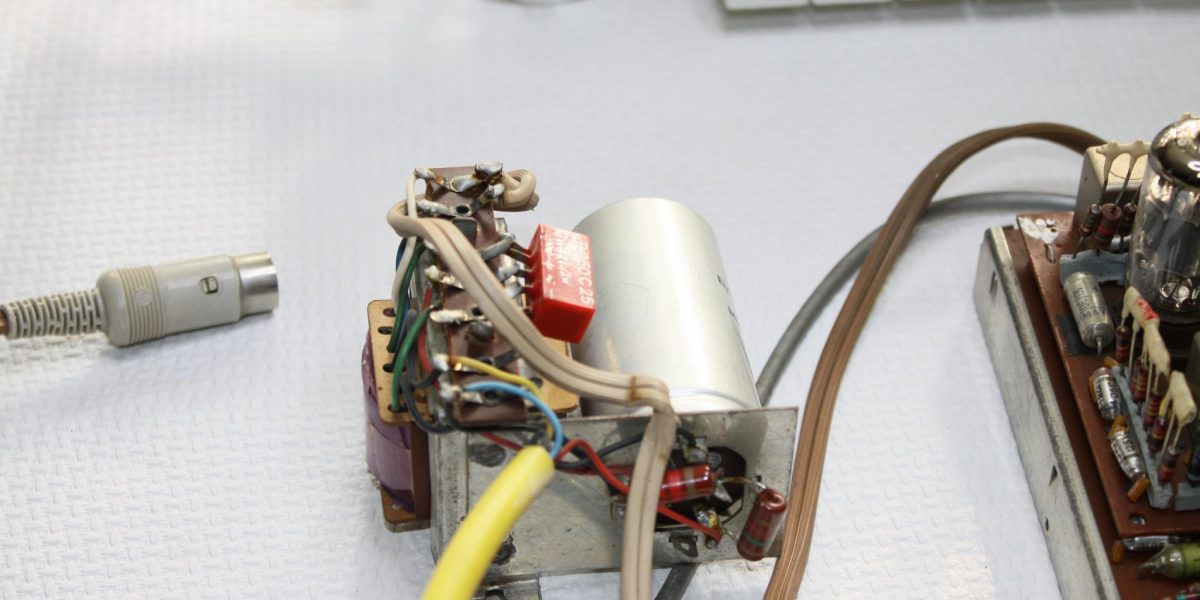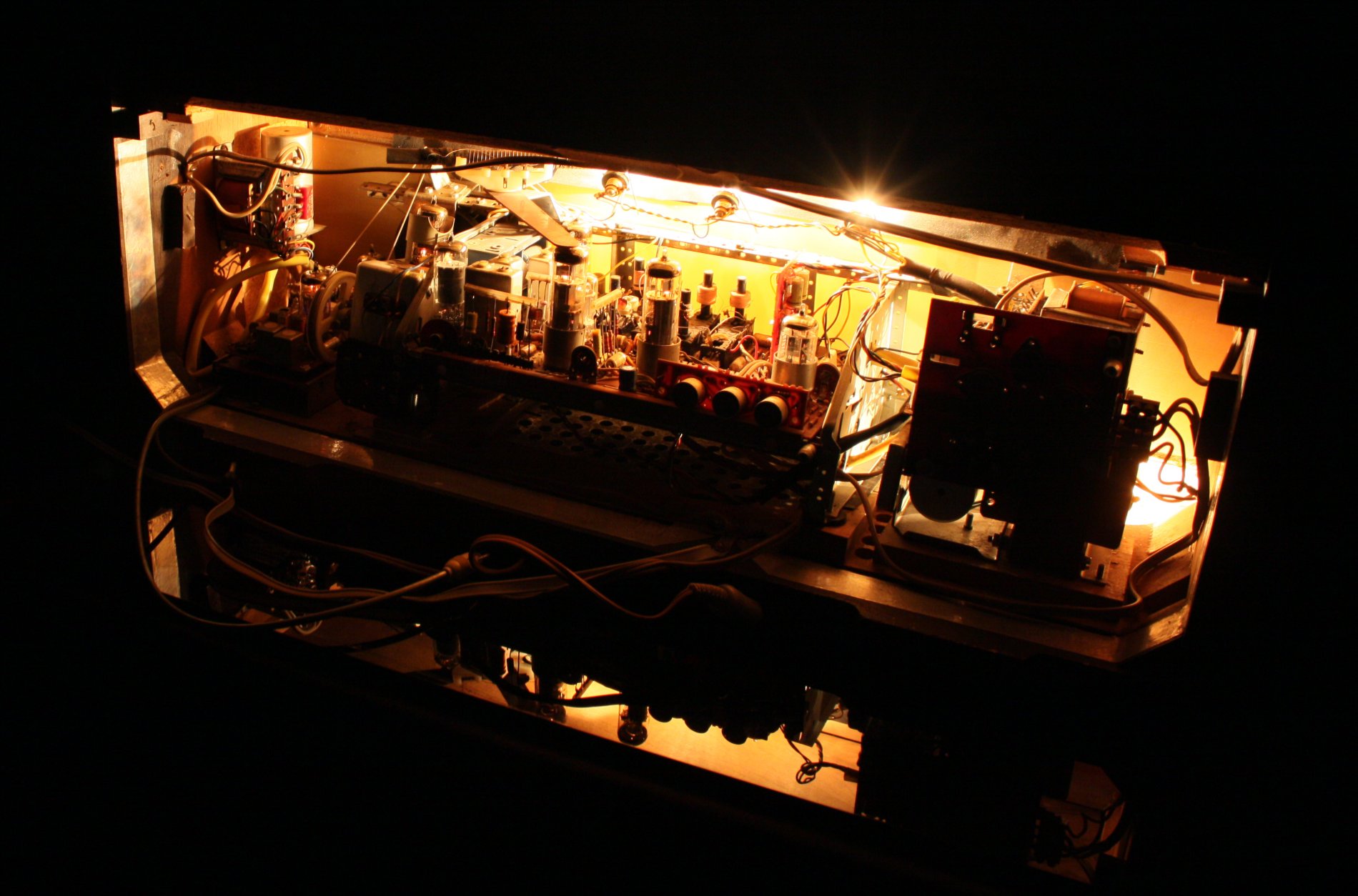 german radios - en
german radios - en
 german radios - en
german radios - en
 german radios - en
german radios - en
 german radios - en
german radios - en



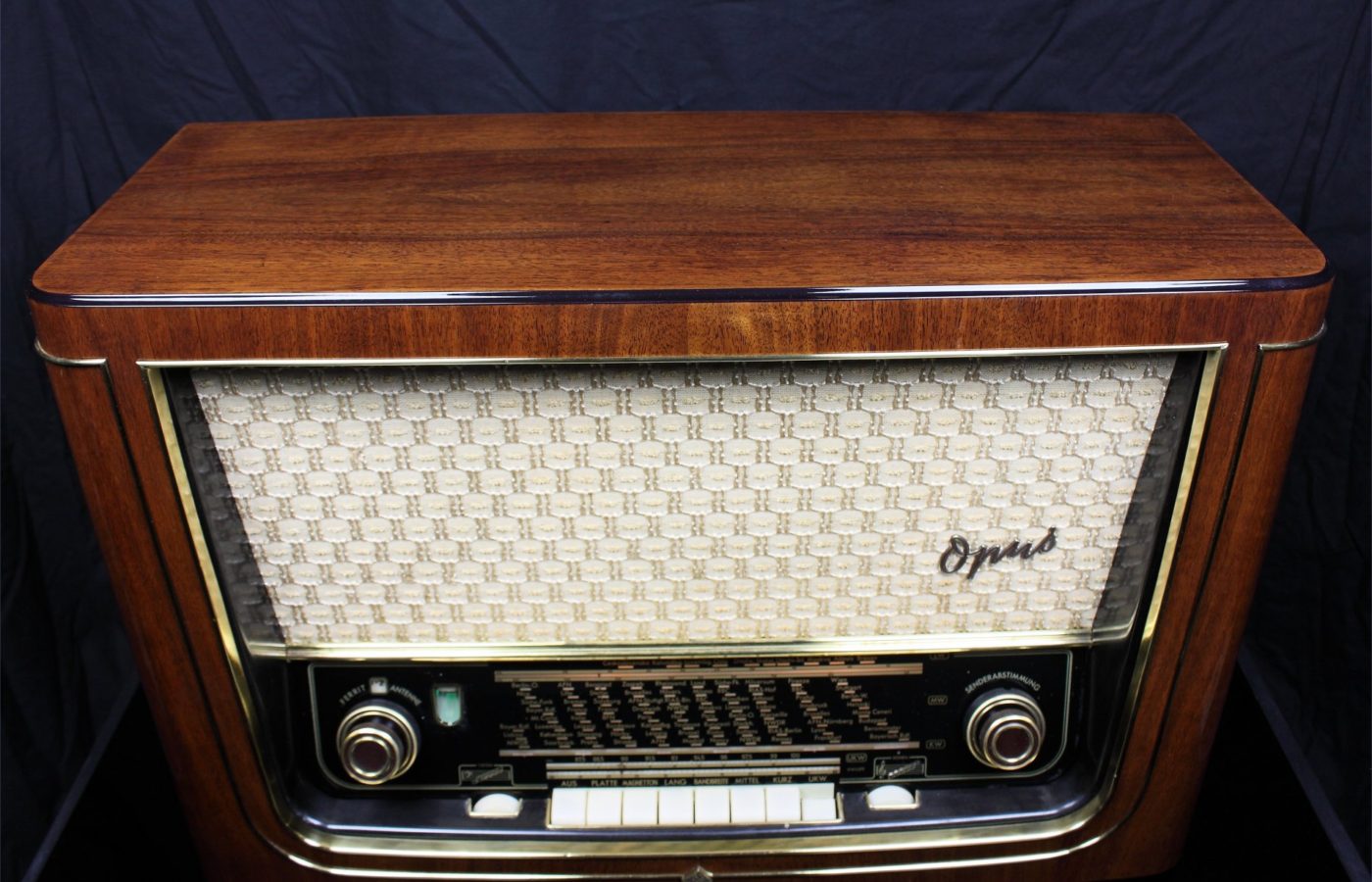


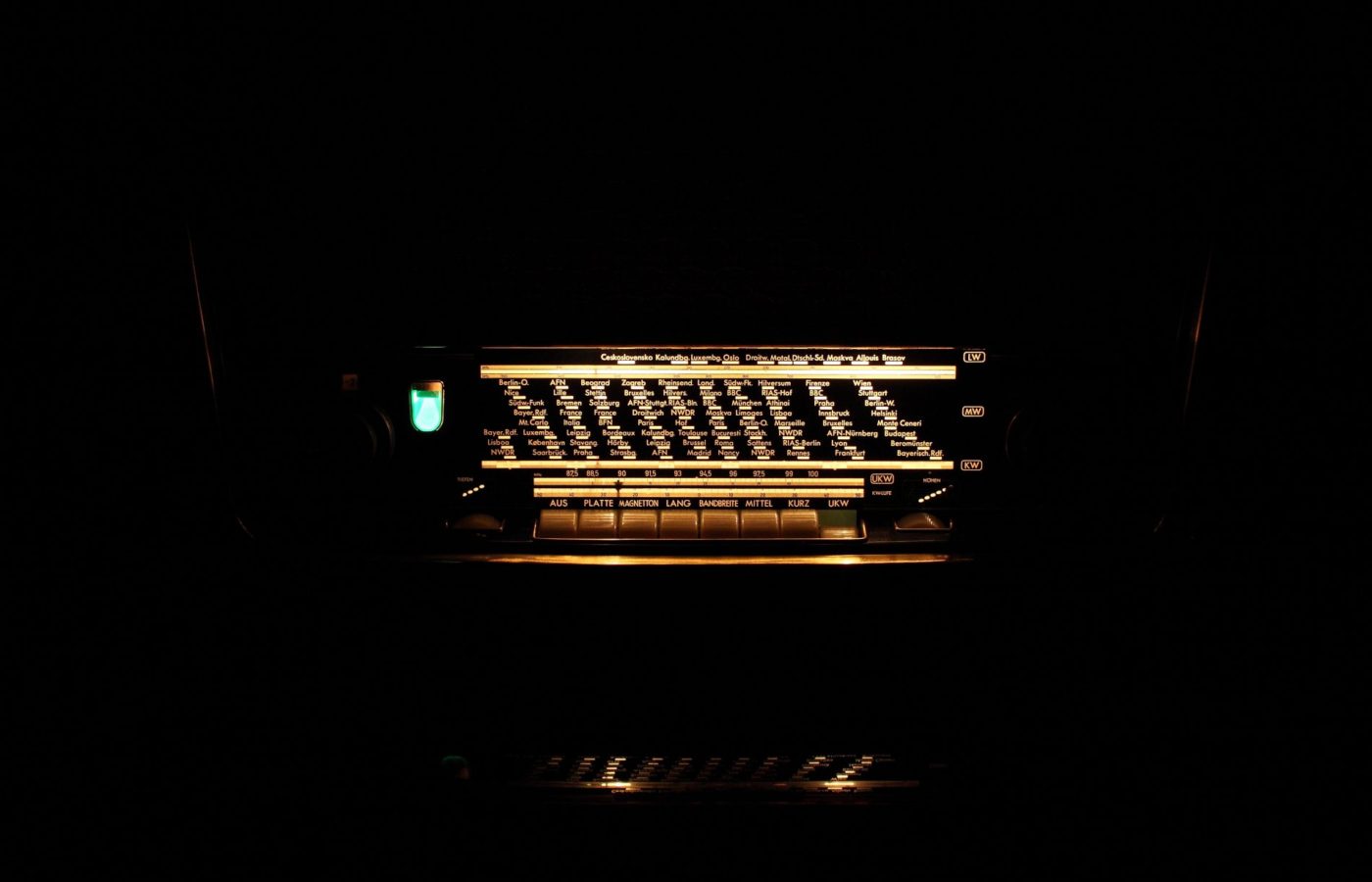





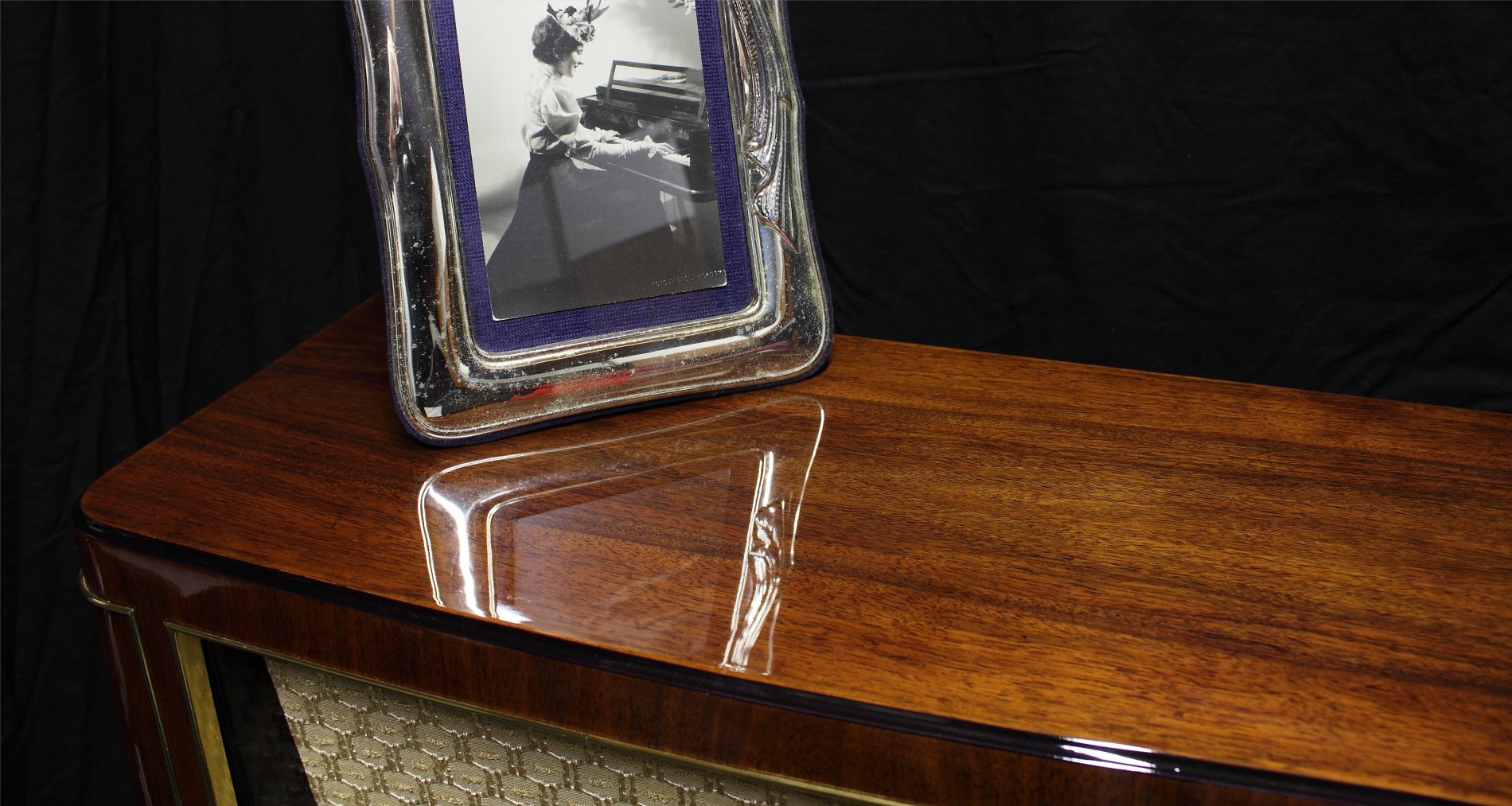
Designed and created in 1954, the OPUS 55 TS was the flagship model of the entire Telefunken production for the years 1954-55.
Since 1949, Telefunken decided to distinguish by the name “OPUS” the radio models at the top of their production. In fact, the first Opus model is the 1949 OPUS 49. This denomination remains until 1978, when the last Opus model, the 7050 HI-FI, is produced. In the following years the different models will be distinguished by alphanumeric abbreviations, such as TR550 and such.
The restoration of this device was very challenging, as the chassis had been cannibalized. As a matter of fact, potentiometers, tube sockets, many components, wires were missing and the HF coils had been torn. In short, the device was in terrible conditions. But a machine like this deserved a much more glorious end and the final result proved us right.
The amplifier stage has been literally rebuilt, the very fine wires of the high frequency coils have been reconnected through a very meticulous work.
The phases of this challenging restoration are documented with photographs, which can be seen at the end of the page in the dedicated section.
The declared output power was 15W but judging by the scheme and the voltages it must deliver about 10.
The good amount of power delivered and the high efficiency of the 6 loudspeakers allow the Opus 55 to successfully sonorize large rooms.
The double medium frequency stage, the complex feedback network, the push-pull output stage make it a classy and elegant radio. The configuration of this device will remain pretty much unchanged also in the following models, until the transition to the production of stereophonic models.
The devices of the Opus series are still among the most wanted by collectors for their extremely high quality standard.
The songs in the playlist highlight the incredible virtuosity of the performers. All these tracks were chosen specifically to put the device to the test. Below is a brief description.
- The first song proposed is a flamenco. Inspired by Playa la Barrosa in Cadiz, Spain, it was composed and interpreted by Paco de Lucia. The talent of the Spanish Maestro makes flamenco enjoyable even for those approaching this peculiar musical genre for the first time.
- With the second track we fly to Paris to meet the Russian-Israeli trumpet player, Sergei Nakariakov. Known as “the Paganini of the trumpet”, Nakariakov's work is fascinating because it continuously experiments with transcriptions of songs composed for other instruments, such as the song proposed here, “Moto perpetuo”, written for violin by Paganini himself.
- The third song, known as “Vento d'inverno”, ranked as op.25 no.11 is a technical study written by F. Chopin in 1836. This study was specifically written with the purpose of developing technique and endurance. It deserves to be seen played live, as it is truly disconcerting. However, Chopin did not mean to impress his listeners with the demonstration of his skills, but he believed his fingers to be “handmaidens of his soul” and with his soul he wanted to be heard, not with ears (H. Heine).
- The fourth track is a 1987 song taken from the album “Surfing with the alien” by guitarist Joe Satriani. An album that was recorded on the cheap, with a very limited budget, the three guitars used by Satriani were modified by him and electronic instruments were used to simulate many drum effects. However, the album was extremely successful thanks to Satriani's skills and creativity. The proposed song is a remastered edition of 2014.
- The last track, “Drum solo”, is a live recording of a performance by Daniel John Erlandsson (Malmö, 1976). Erlandsson is a Swedish drummer, who became successful with the metal band Arch Enemy. It is characterized by a very precise ritmica suono that mixes classic metal passages with the death-metal typical of his band. The song is undoubtedly exciting even for the non-lovers of the Metal genre.


- Built-in Bluetooth receiver - This unit can be equipped with a BLUETOOTH receiver powered directly from the device. That makes it possible to use the amplifier from any digital device, IPAD, Smartphone, or sophisticated multimedia station. You can listen to your wireless Web Stations or favorite music around the room. On request, we can also mount a Wireless Receiver.
- Multi Platform connections - Along with the device, we can also provides you an impedance adapter cable to connect any digital source, such as iphone, smartphone, computer, CD player, etc. This purpose-built cable adapts different impedances of modern digital equipment. Also the two stereo channels are collected into a single flow without increasing the load input unit.



1903 To prevent the English Marconi Company from having a monopoly on wireless transmissions,,Kaiser Wilhelm II orders the company AEG and Siemens to set up a joint venture to develop wireless telegraphy in Germany. It was established under the name of Gesellschaft für drahtlose Telegrafen mbH.
1923 The company name is changed to Firmierung in Telefunken, Gesellschaft für drahtlose Telegrafen mbH. Abbreviated as Telefunken, where Tele means Telegraph and Funken means "Lightning" in the sense of being fast and immediate.
1930 Production gradually moves from military and Government equipment to the production of consumer appliances. During this period, Telefunken enters the market of radio-television, recorders and etching of records.
1930 As radio transmissions are now needed not only to transmit telegraph messages, but also true music and speech broadcasts, it becomes necessary to introduce the concept of sound compression, to avoid continual volume level changes of the radio. Telefunken designs and produces the U3, the first compressor for transmitting stations in the world,. TheU73b, as seen in the picture, represents the evolution of previous models—it allows you to change the compression level, the release times and the attack times.
1941 All Telefunken’s actions are transferred to AEG, which effectively becomes the sole owner of the trademark Telefunken, its factories and patents.
1948 Germany is not invited to the Copenhagen Conference, where the division of Medium and Short Wave radio frequencies of Central Europe is decided. The war has just ended, and officially Germany isn't considered as a technologically important nation. Because of this, Germany decides to develop FM broadcasts even if the quality of the transmissions is considerably higher than those in the AM. At this time, Telefunken develops the V72 microphone/amplification system and its evolutions, intended to be used in all German broadcasters and most European ones too, as well as at the most important recording studios, such as EMI, Decca, Telefunken, etc.
1955 The company becomes Telefunken GmbH.
1967 Telefunken is joined with AEG and the company becomes ‘’AEG-Telefunken’’.
1970 Poor management causes the company to lose market shares. AEG begins to outsource entire business segments and make constant rearrangements.
1985 Daimler-Benz AG buys what remains of AEG-Telefunken.
1996 The name Telefunken is cleared and all activities related to audio products stop.
Today The company name has been renewed in Telefunken Holding AG. Telefunken and its use worldwide are responsible for the name. In United States Telefunken USA buys the rights to build and market worldwide original microphones and some audio equipment under the brand Telefunken Elektroakustik.
The original company that helped spread the music throughout the world doesn’t exist anymore.
Year of production: 1954/55
Superheterodina IF 460/10700 8 Circuiti AM 11 Circuiti FM
Wavebands:
Medium Waves (OM), Long Waves (OL)
Short waves (OC), FM (UKW)
VOLTAGE (AC) 110; 125; 160; 220 Volts
6 Loudspeakers
2 Main Mid-Woofer
2 Front electrostatic Tweeters
2 Cone Tweeters on sides
Dimensions (LHD): 640 x 420 x 280 mm / 25.2 x 16.5 x 11 inch
Net weight: 15,7 Kg
9 Tubes: ECC85, ECH81, 2 x EF89, EM80, EABC80, EC92, 2 x EL84
Rotating ferrite antenna for AM bands
This device is equipped with a set of 6 loudspeakers.
Only the Saba Freiburg 14, the Nordmende Tannhauser 59 and some later models of the Opus series are equipped with the same number of loudspeakers. All other German radios, even top-quality ones, have 5 loudspeakers at most.
In the front we find two wideband loudspeakers and two electrostatic tweeters. These loudspeakers are very directional so they are fixed to a prism structure that directs them so that the resulting spread angle is as wide as possible.
Two 10 cm cone tweeter are placed on the sides, cut with a 6 dB/oct filter so that along with the treble they also reproduce medium-high frequencies. The whole audible spectrum is then spread evenly in all directions, granting the listener a complete freedom of movement.
The frontal loudspeakers visible in these photos are not Telefunken originals. All the other loudspeakers are original.
Inside the Cabinet there is a dipole to receive FM bands and Shortwaves. A ferrite rotating antenna is for long and medium waves reception. The ferrite antenna can be rotated from the outside to collect the maximum possible signal while receiving two AM bands.
In the picture you can see the entire mechanism of the antenna’s rotation. Using the internal antennas, the sensitivity is very good. Of course, under some conditions, using an external antenna further increases the receiver’s sensitivity.
The tuning system is interesting and different than other devices made in Germany. The device is equipped with separate tuning mechanisms for AM and FM bands. There are two tuning knobs, separate but coaxial, with cable and pulley systems separated depending on the band. This type of tuning has a very strong mechanics.
Regarding maintenance, cleaning and lubricating once every 10 to 15 years is sufficient.
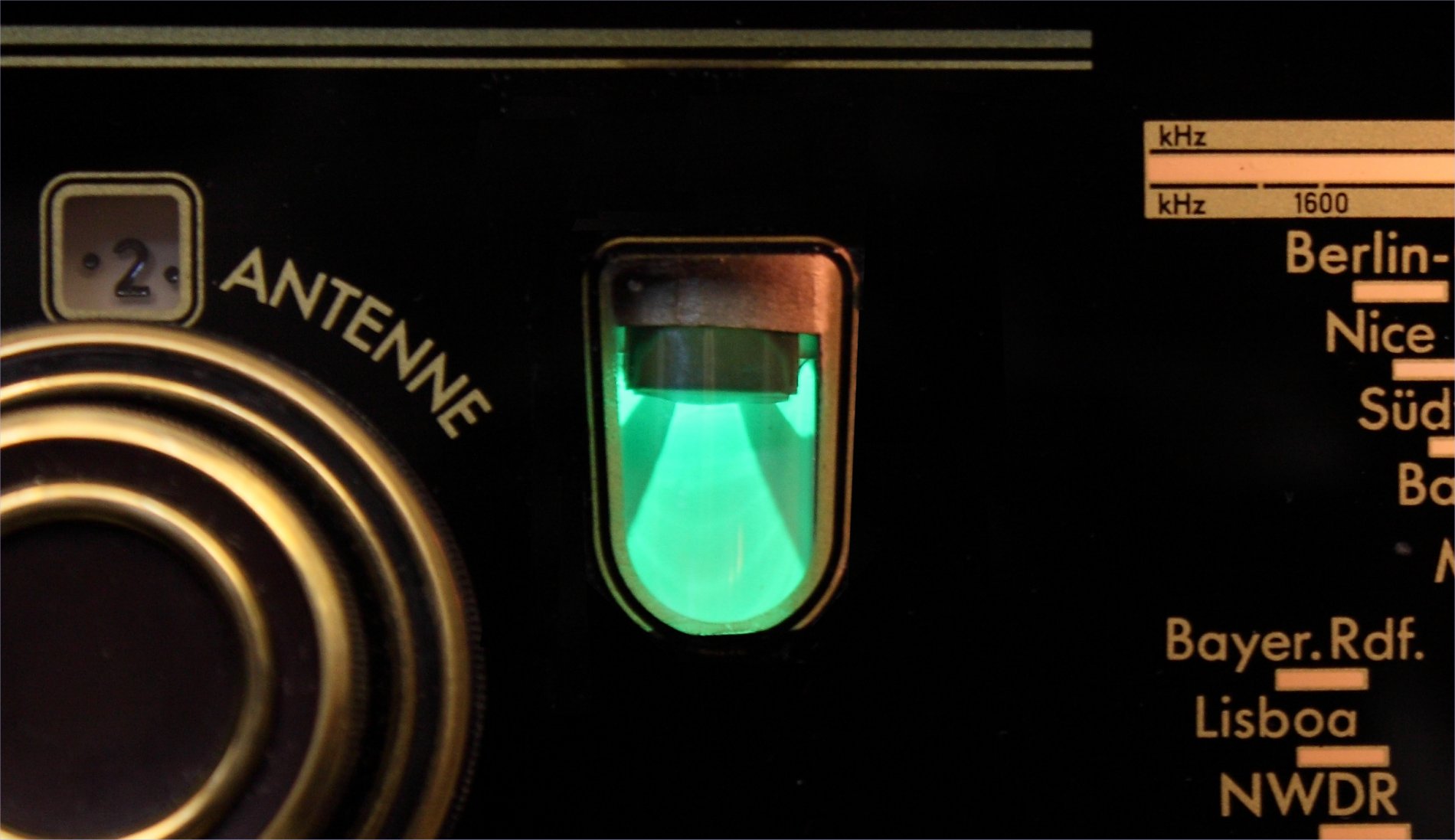
The magic eye has of course been replaced.

To the right is the volume controls (with built-in loudness)
On the same axis the larger knob controls the position of the Ferrite Antenna. A small window indicates its position.
Then we find the Magic Eye, which indicates the perfect tuning position for each station.
Just below there’s the Bass control knob. On the staff the notes change color depending on the position of the knob.
At the top we can find the dial glass.
Below, in order,
AUS - OFF
PLATTE - Turntable
MAGNETTON: Tape Recorder
LANG - LW (long wave),
BANDREITE - Bandwidth control in AM
MITTEL - MW (medium wave)
KURZ - KW (shortwave)
UKW - FM
Finally there are AM/FM coaxial Tuning knobs.
Below, you can see the high-tone control knob with its indicator.





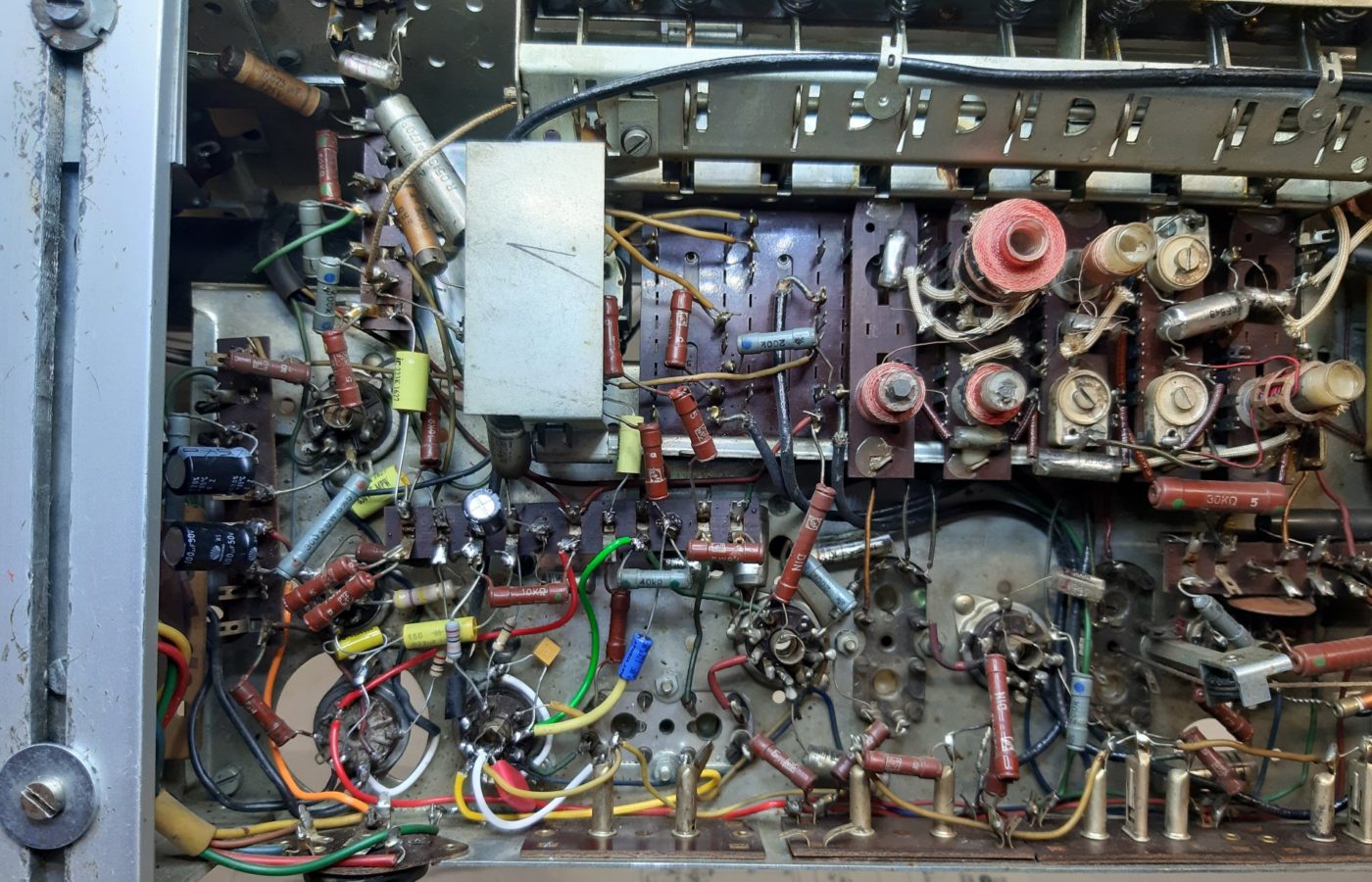

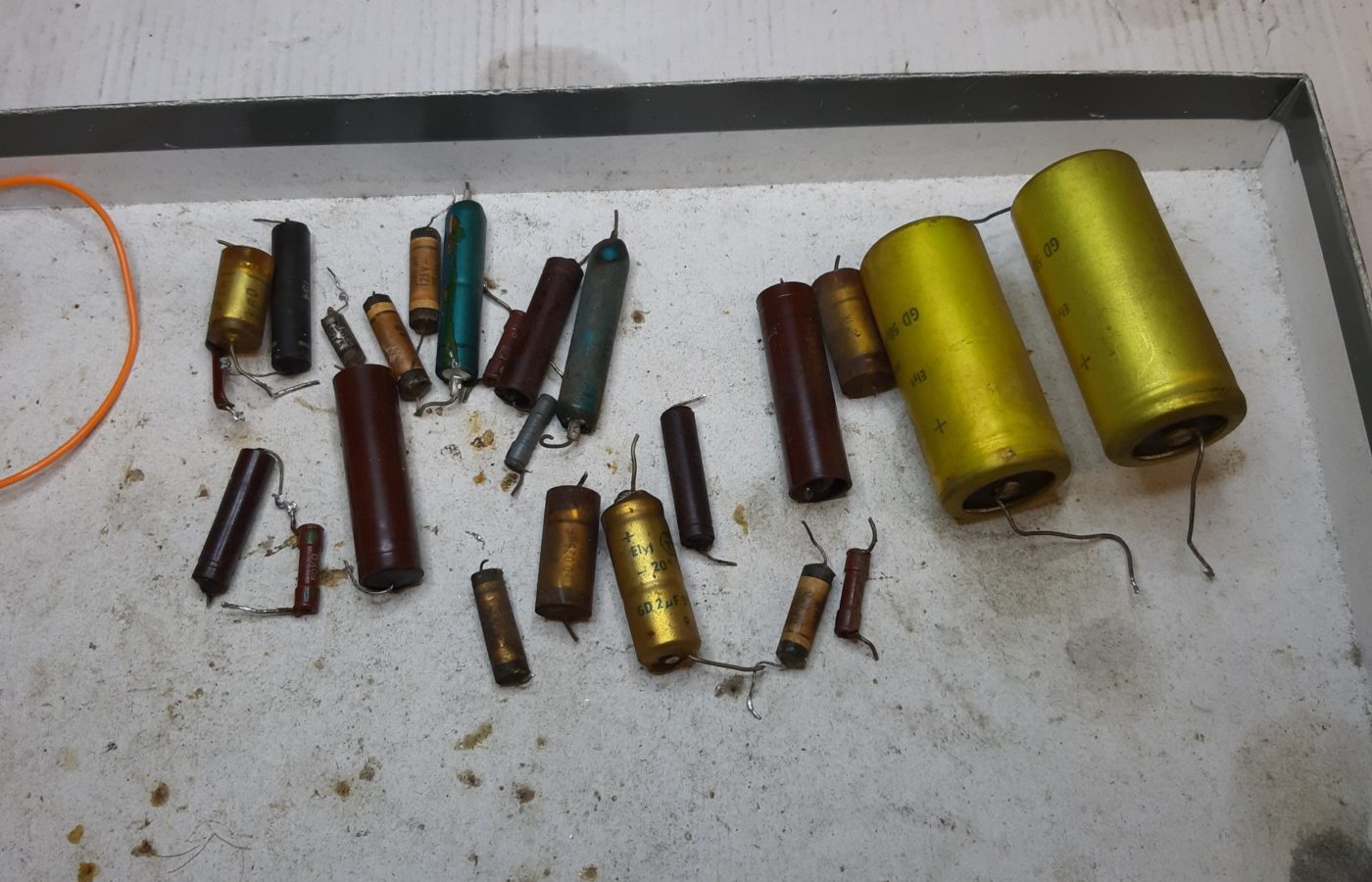









 german radios - en
german radios - en
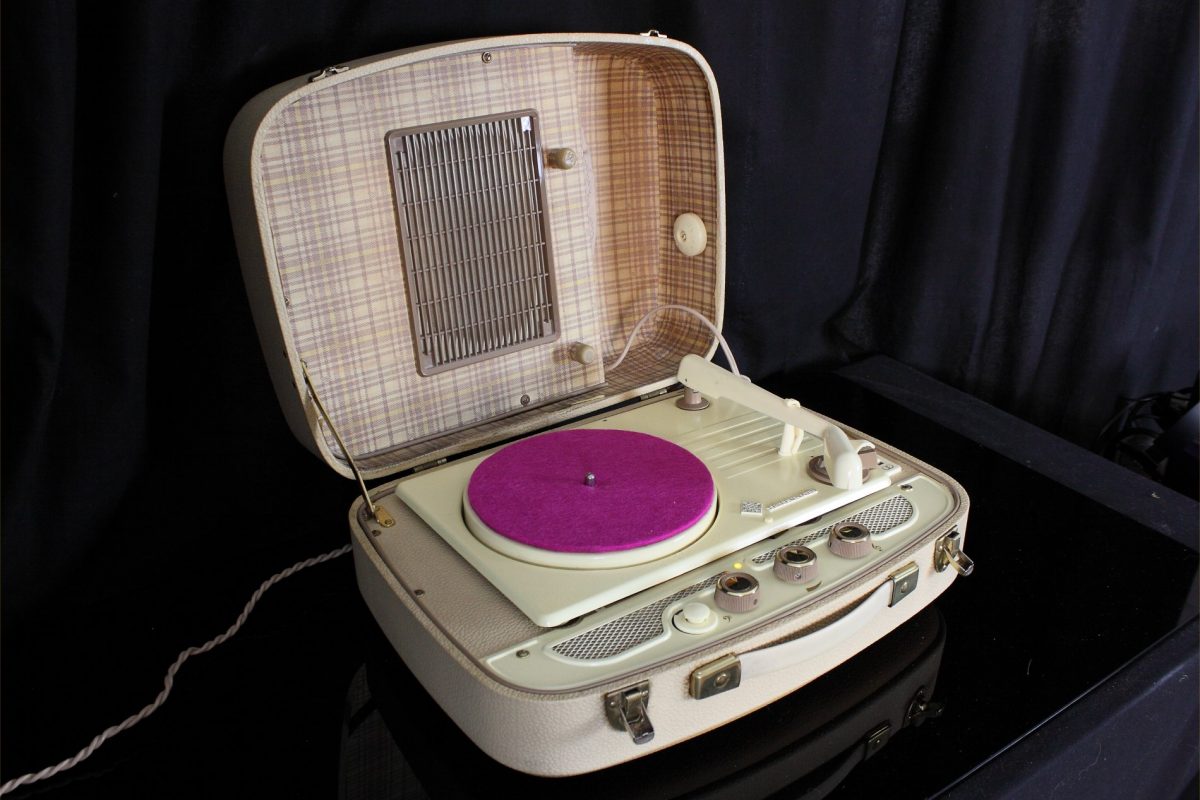
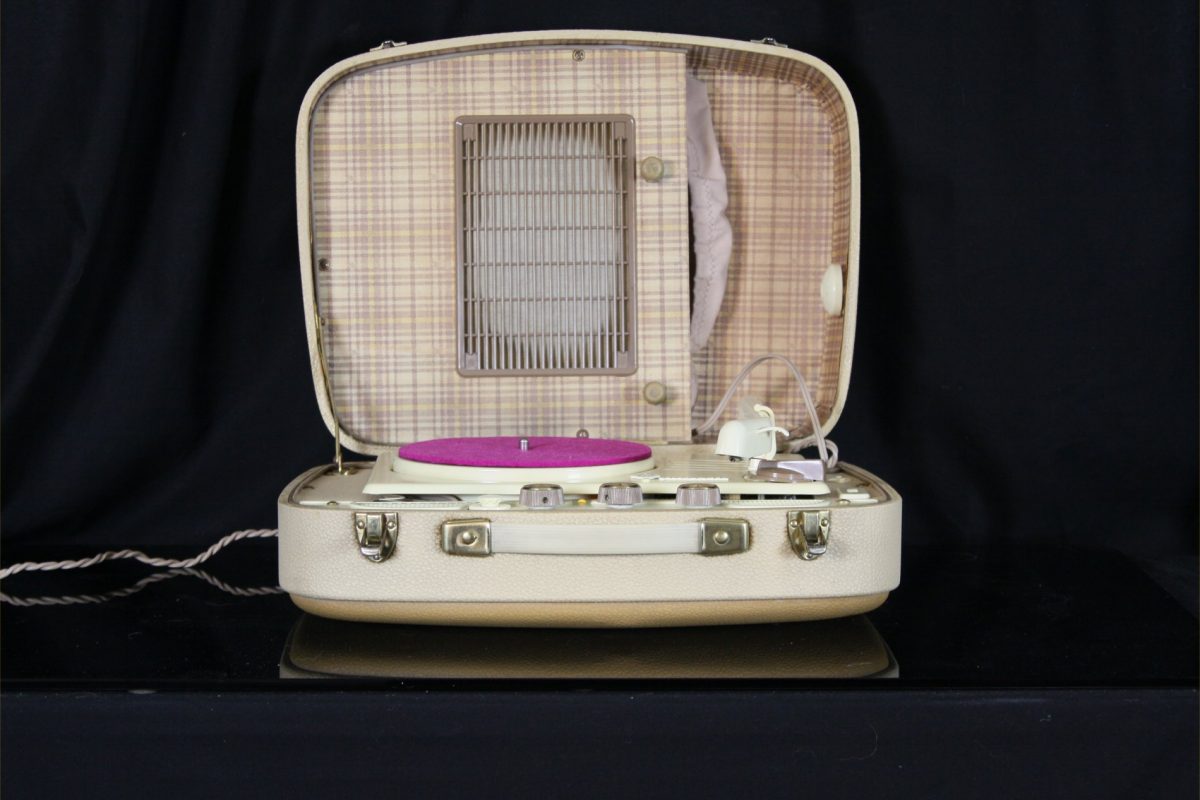






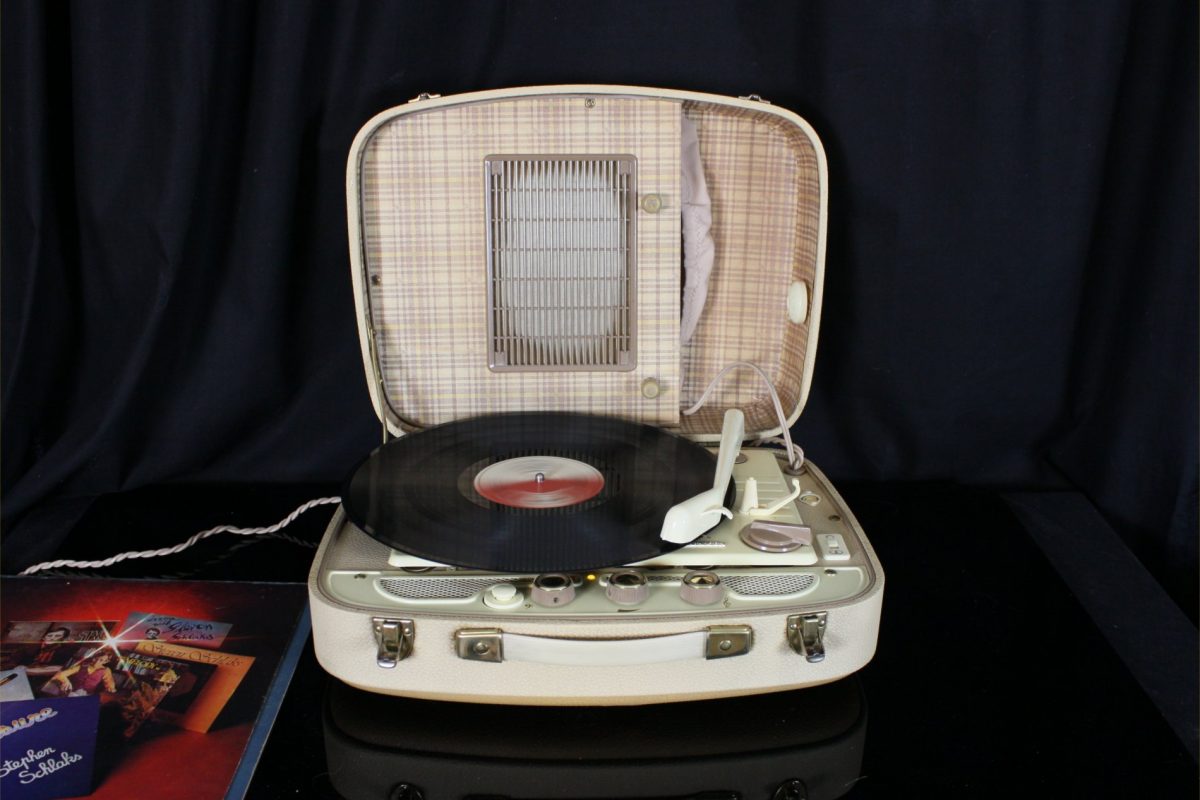


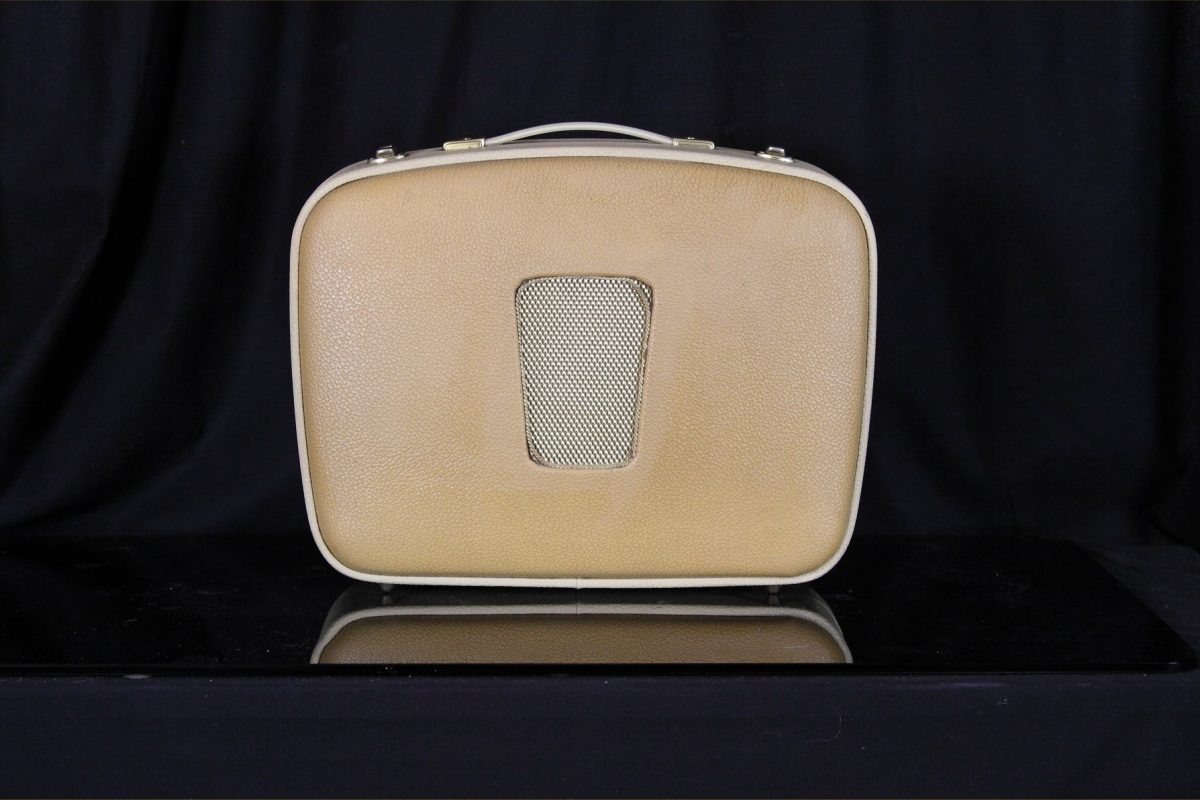
The Telefunken Musikus 5SV is one of the best portable record players built in Germany between 1960-1961.
The mechanical part is comprised of a robust Telefunken belt record player.
The record player is equipped with automatic antiskating set at the factory. It can play discs at 16/33/45/78 rpm.
It is not automatic for which the mechanics are very simple, robust and silent.
It can assemble monophonic or stereo stylus.
The electronics are established from an ECL82 polarized in A-Class.
The triode section of the ECL82 is used as a preamplifier. Between the preamplifier stage and the final stage there are separate tone controls for acute and bass.
Interestingly, the physiological control of the volume consists in three separate levels which intervenes in succession to the volume decreasing.
That physiological control is applied to both potentiometer sections. Another important feature is the ability to connect to an external amplifier, with its loudspeaker, to listen in stereophonic mode.
The traditional use is to connect the output of this record player to the input of a radio.
It is enough to turn the stylus and the Stereo/Mono switch to the Stereo position.
In this way, one channel will be audible from the loudspeaker of the portable record player, the other channel will be audible from the radio’s loudspeaker.
Activating the volume knob of the portable record player, it will act simultaneously on both channels.
The tone controls of the two devices remain separate and independent.
The listening in Mono does not require any additional equipment.
The sound is typical, substantial, sweet and obviously relaxing.
The acute tones are brilliant and the bass is quite quietly present …..within the limits imposed by the laws of physics.
A beautiful portable stereo player with the final stage “Single Ended” in A-Class, enclosed in very refined furniture.
An object which you can enjoy the transmissions of times past.
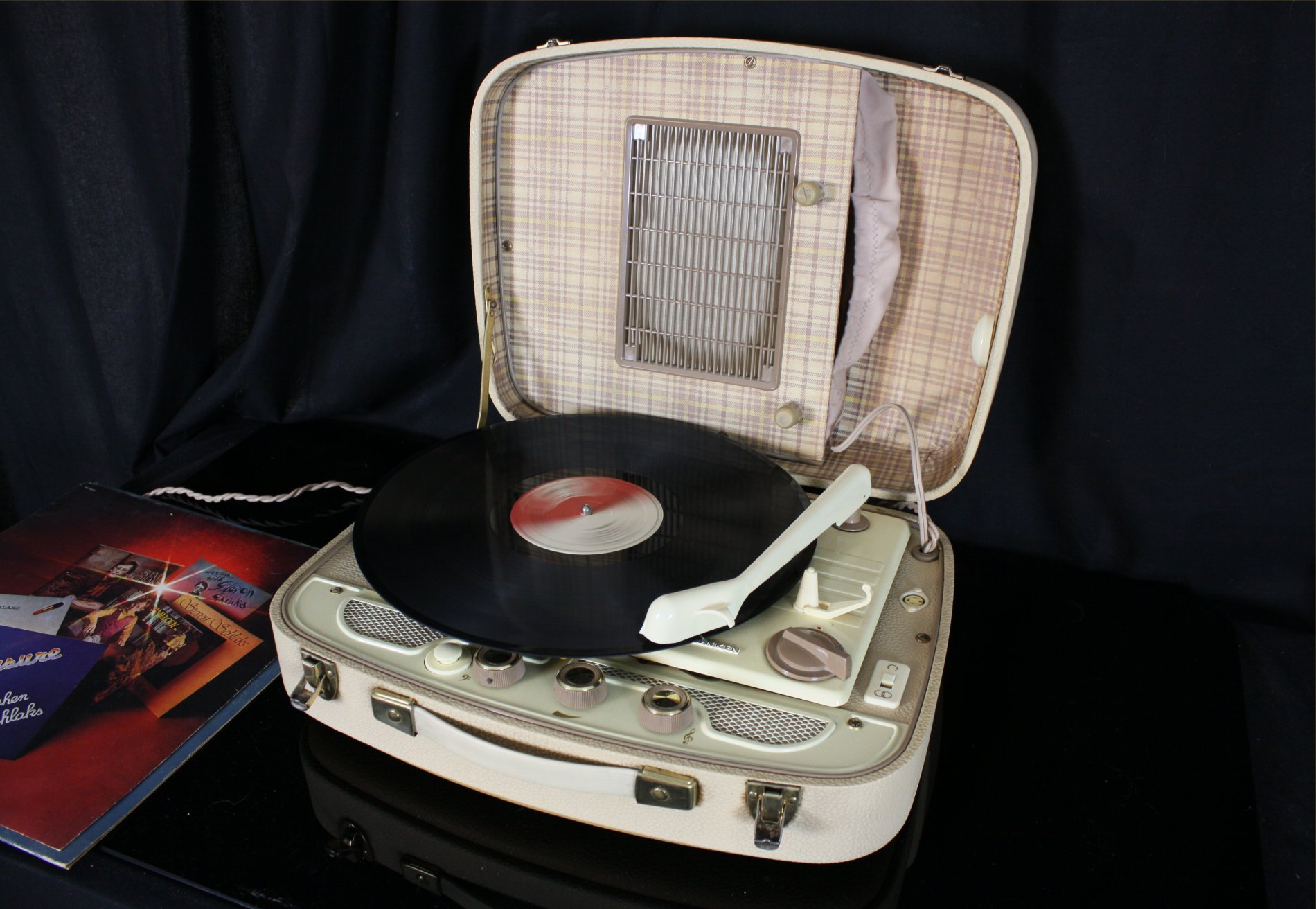



1903 To prevent the English Marconi Company from having a monopoly on wireless transmissions,,Kaiser Wilhelm II orders the company AEG and Siemens to set up a joint venture to develop wireless telegraphy in Germany. It was established under the name of Gesellschaft für drahtlose Telegrafen mbH.
1923 The company name is changed to Firmierung in Telefunken, Gesellschaft für drahtlose Telegrafen mbH. Abbreviated as Telefunken, where Tele means Telegraph and Funken means "Lightning" in the sense of being fast and immediate.
1930 Production gradually moves from military and Government equipment to the production of consumer appliances. During this period, Telefunken enters the market of radio-television, recorders and etching of records.
1930 As radio transmissions are now needed not only to transmit telegraph messages, but also true music and speech broadcasts, it becomes necessary to introduce the concept of sound compression, to avoid continual volume level changes of the radio. Telefunken designs and produces the U3, the first compressor for transmitting stations in the world,. TheU73b, as seen in the picture, represents the evolution of previous models—it allows you to change the compression level, the release times and the attack times.
1941 All Telefunken’s actions are transferred to AEG, which effectively becomes the sole owner of the trademark Telefunken, its factories and patents.
1948 Germany is not invited to the Copenhagen Conference, where the division of Medium and Short Wave radio frequencies of Central Europe is decided. The war has just ended, and officially Germany isn't considered as a technologically important nation. Because of this, Germany decides to develop FM broadcasts even if the quality of the transmissions is considerably higher than those in the AM. At this time, Telefunken develops the V72 microphone/amplification system and its evolutions, intended to be used in all German broadcasters and most European ones too, as well as at the most important recording studios, such as EMI, Decca, Telefunken, etc.
1955 The company becomes Telefunken GmbH.
1967 Telefunken is joined with AEG and the company becomes ‘’AEG-Telefunken’’.
1970 Poor management causes the company to lose market shares. AEG begins to outsource entire business segments and make constant rearrangements.
1985 Daimler-Benz AG buys what remains of AEG-Telefunken.
1996 The name Telefunken is cleared and all activities related to audio products stop.
Today The company name has been renewed in Telefunken Holding AG. Telefunken and its use worldwide are responsible for the name. In United States Telefunken USA buys the rights to build and market worldwide original microphones and some audio equipment under the brand Telefunken Elektroakustik.
The original company that helped spread the music throughout the world doesn’t exist anymore.
Year of production: 1963
VOLTAGE (AC): 110; 125; 160; 220 Volts
Loudspeaker Larga banda frontside magnet
Dimensions (LHD): 410 x 170 x 310 mm / 16.1 x 6.7 x 12.2 inch
Net weight: 4.5 kg / 9 lb 14.6 oz
1 tube: ECL82
Cartridge T20 - T20/2
Speed 16/33/46/78 rpm
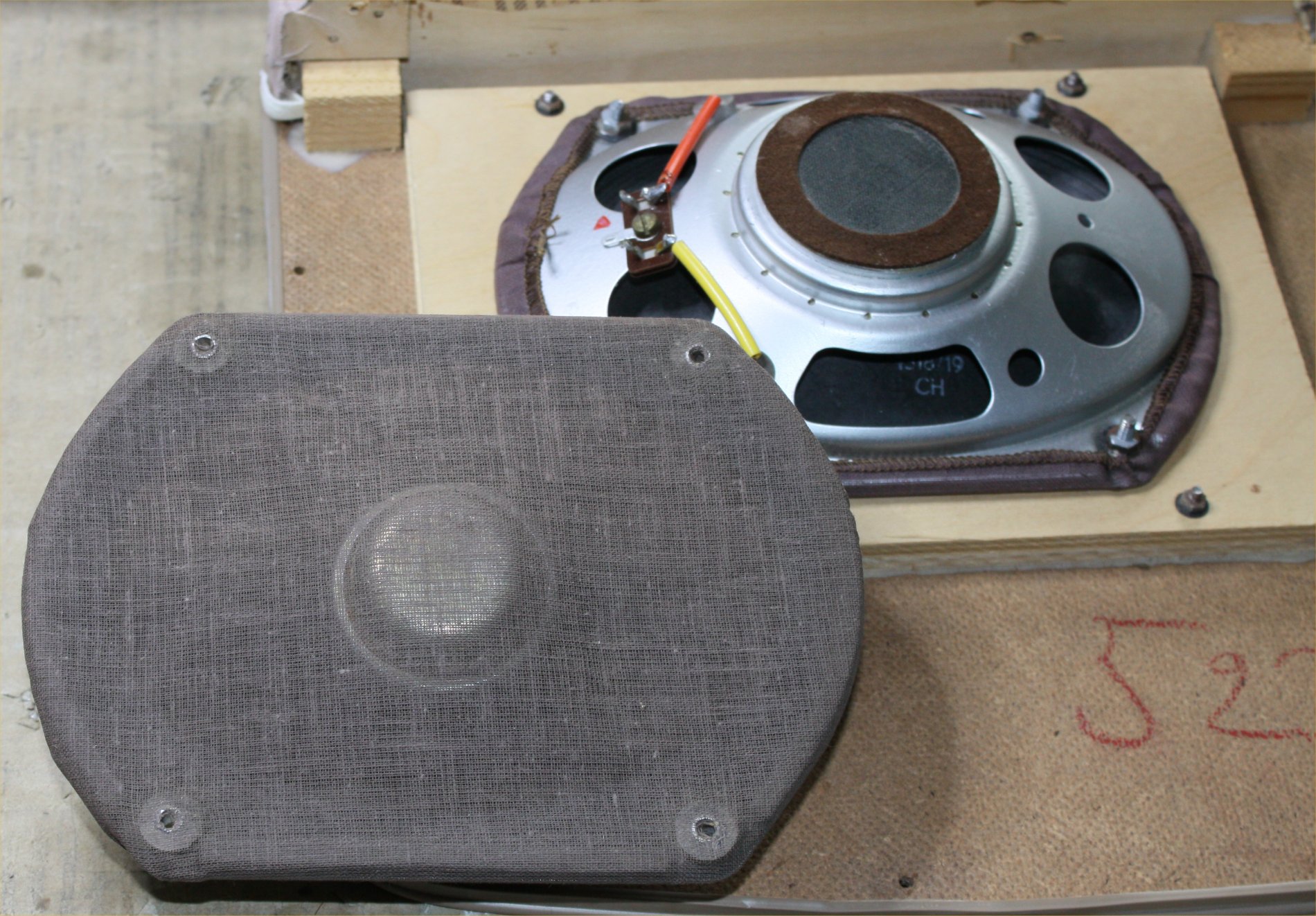
The loudspeaker of this device is very interesting.
Since it has been placed on the top of the lid of the cabinet, it has been necessary to contain the depth.
To do this, the magnet and the reel have been moved to the front of the speaker, in front of the cone.
The cone curvature is also minimized.
With these clever solutions the depth has been limited to a few inches.
The frequency response of a loudspeaker with the profile is shifted to the acute, which is really brilliant.
The cabinet built on the lid, allows the low range to be emphasized, so at the end the frequency response is rather linear.
Another important feature, that reveals the class of this device, is the tone control circuit, which consists of two separate sections for high and low frequencies.
Somewhat different to the circuits usually used in German production, here the controls are independent from the volume control position.
These controls act naturally only on the internal amplifier, not on that additional amplifier.


In the photo, on the left you can see the 3 poles DIN socket, to which it is possible to connect an additional amplifier, as specified in the presentation of the device.
When the switch is in the Mono position (a circle) on both amplifiers the internal one and the additional one, the same signal arrives.
When the switch is in the Stereo position (two circles) to the two amplifiers the signal arrives separately in the two channels. This is controlled by the volume potentiometer which consists of two equal sections.

The first command you can see to the left is the voltage changer. It should only be used at the beginning to adjust the voltage of the record players’ operation to that of the network.
Then, it must no longer be touched.
The second command is the control of low tones of the internal amplifier, to follow the potentiometer of the volume (of both channels)(di entrambi i canali)
and finally, the acute tones control knob.
Above you can see the big knob of the speed control of the record player.
At the end, the Mono/Stereo switch and the output for an additional amplifier.


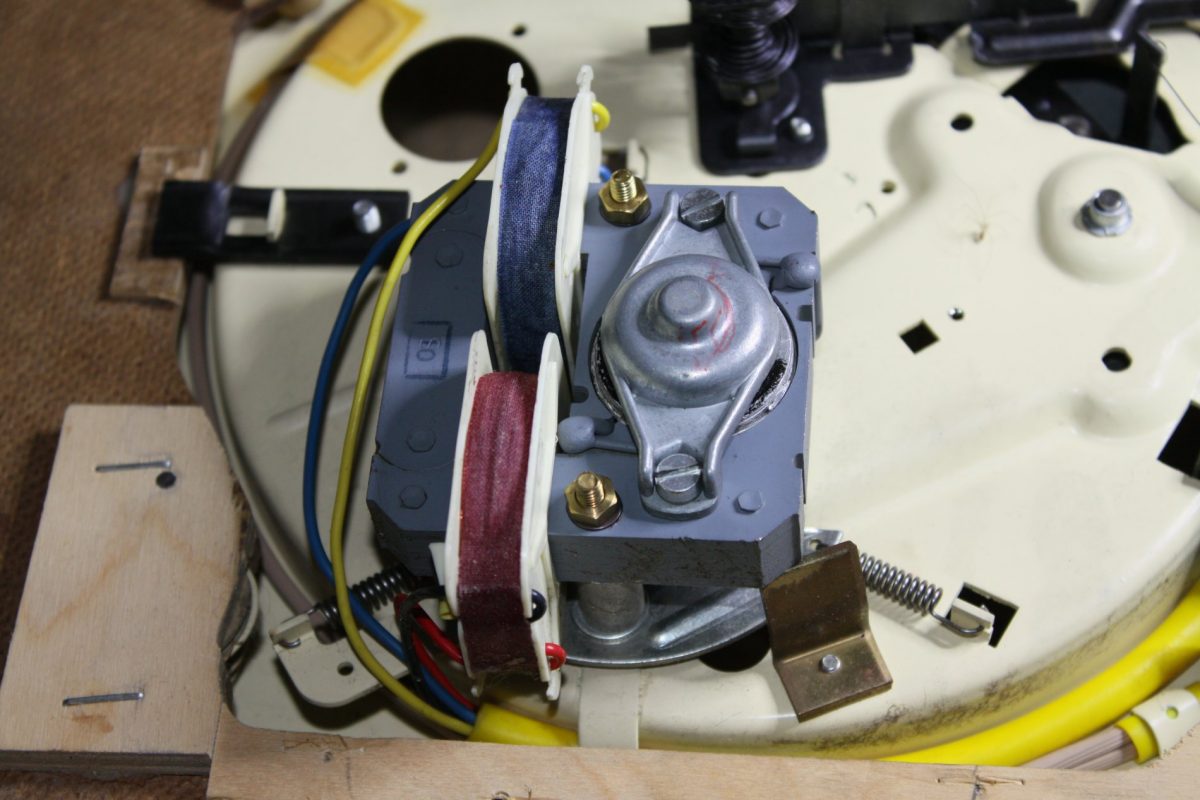
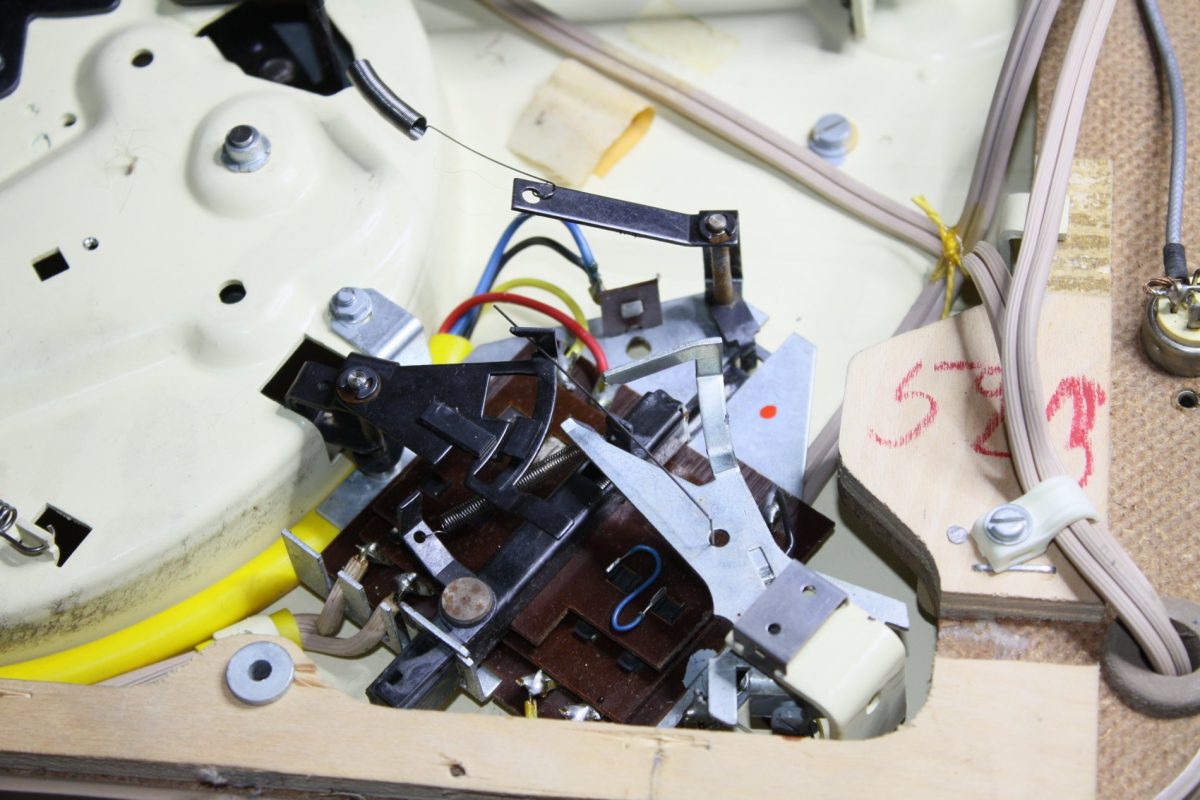




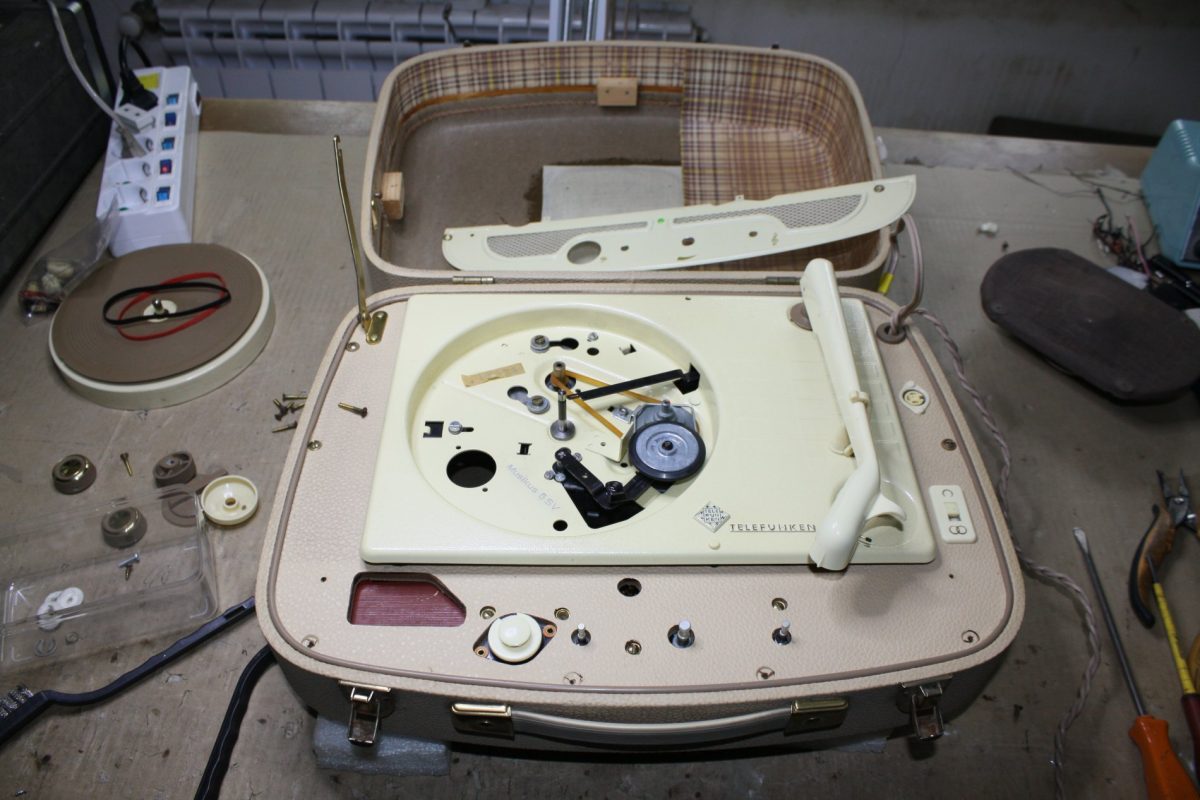
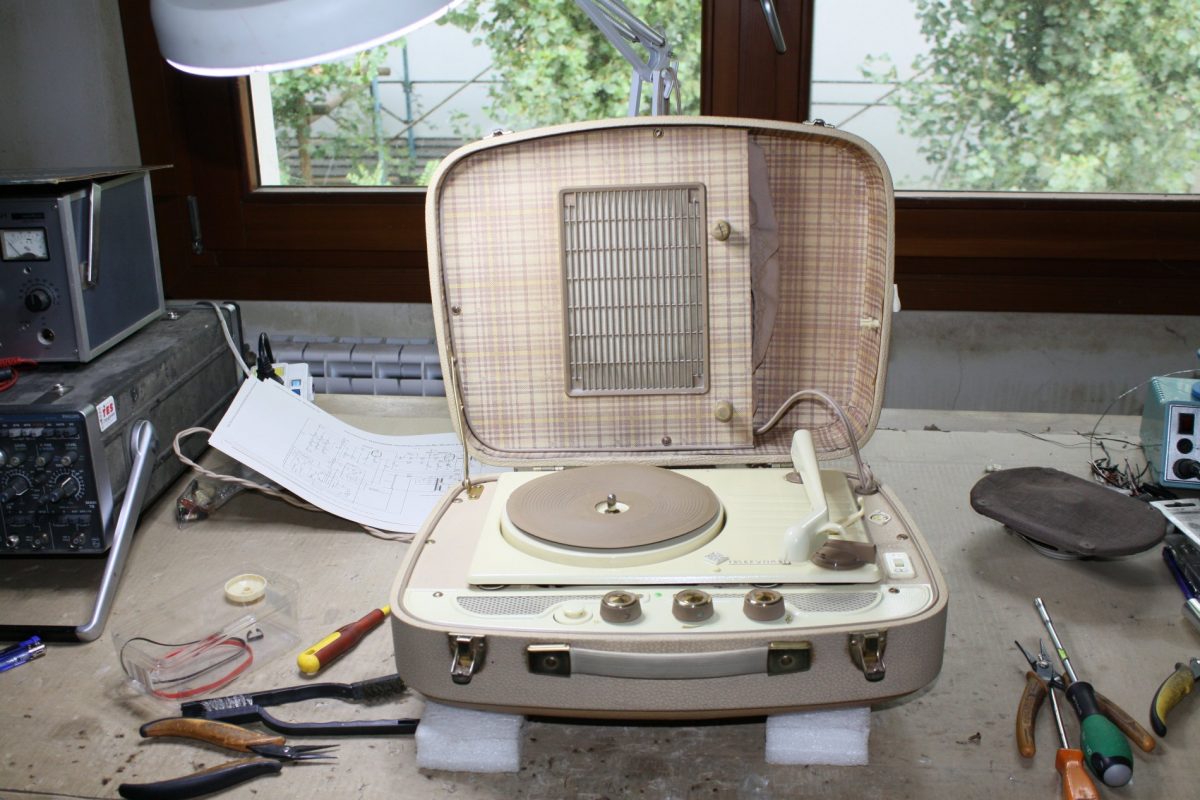
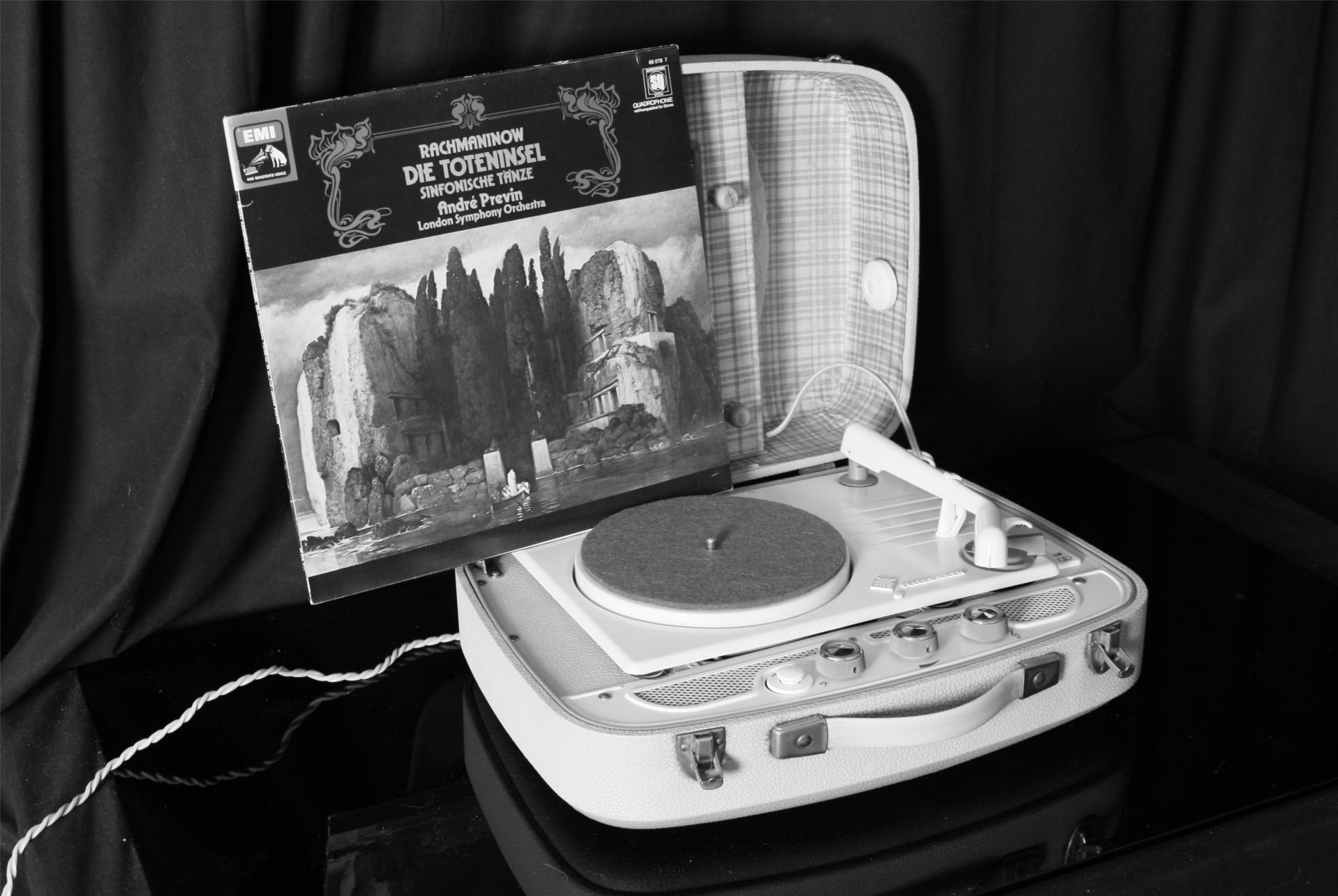
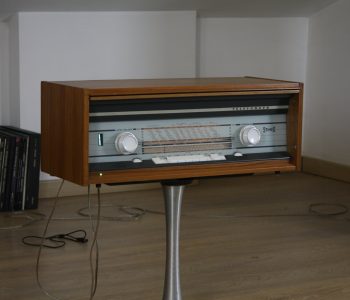 german radios - en
german radios - en






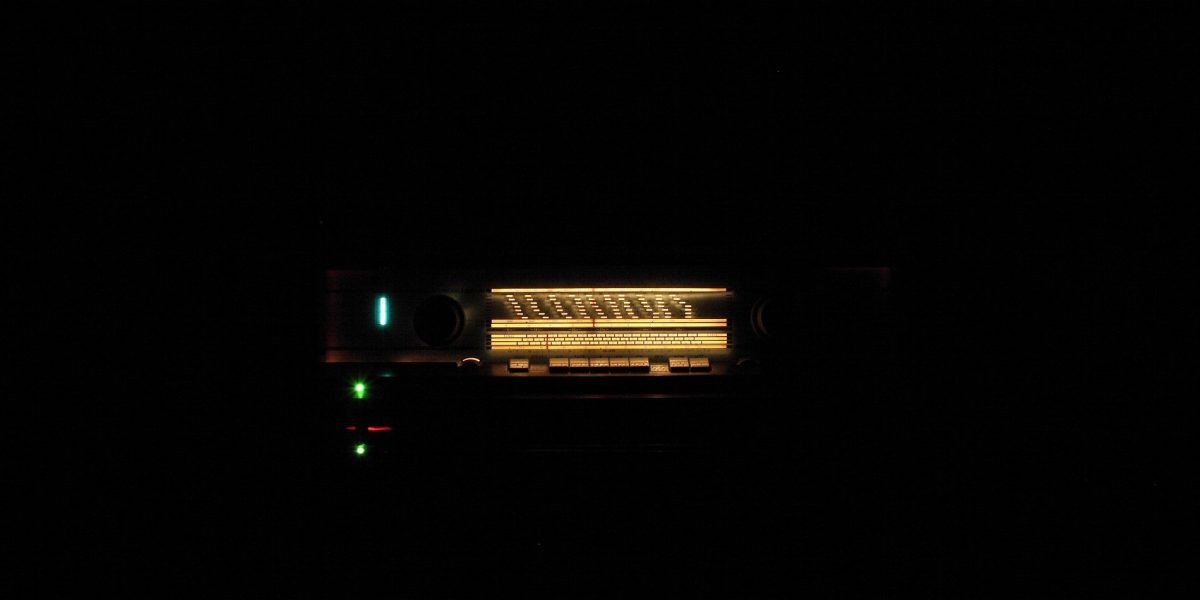



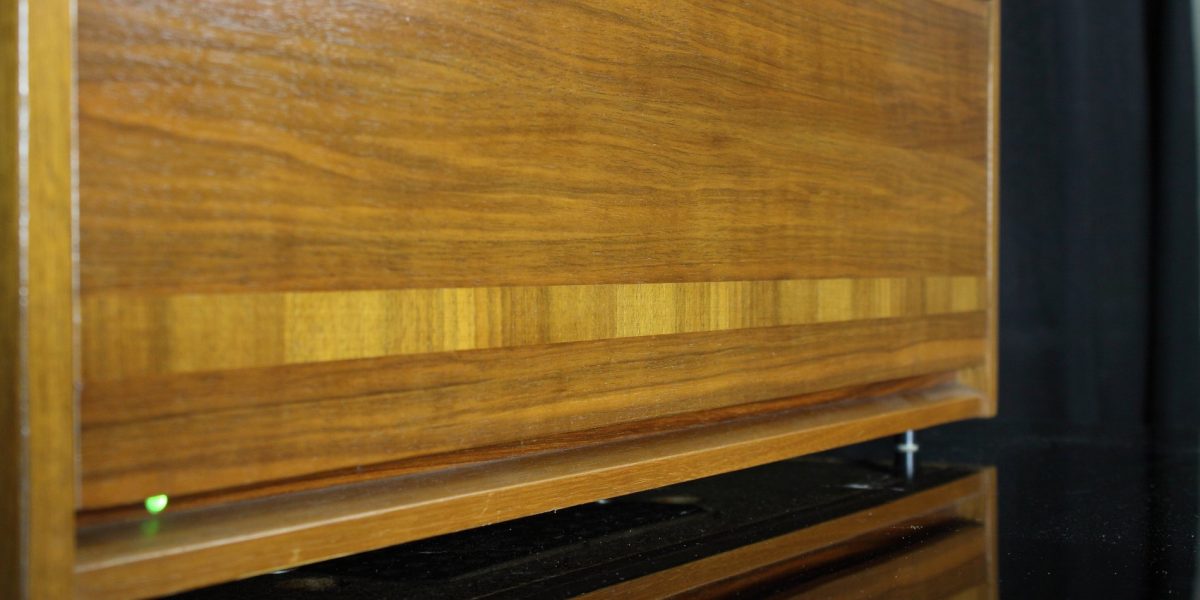



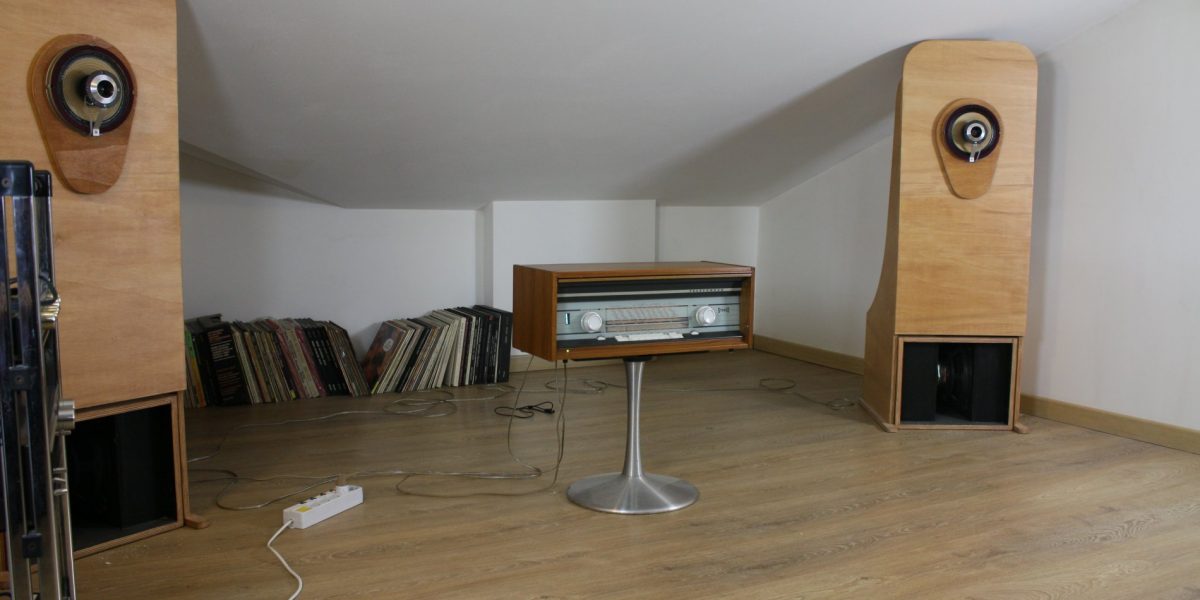



Around the early 1960s, the biggest German manufacturers put what we now call "receivers" on the market. They called them Steuergerät, which means Electronic Control Unit. The Telefunken Concertino Steuergerät 2380 is one such device.
The Telefunken produced two lines of Steuergerät, one with output stage in A class and the other in AB class. The Concertino 2380 had its output stage in A class, while the Opus 2430, and then the Opus 2550, had their output stage in AB class.
The Concertino has the same sizes, the same cabinet than Opus 2550. The Opus models are more powerful, with 7 W per channel, while the Concertino has 4 W per channel, but 4 W in A class makes the difference.
Another big difference between the Opus and the Concertino is that the Opus was designed with an embedded stereo decoder, while in the Concertino the decoder was optional. All our Concertinos are equipped with a stereo decoder.
The final tube in the Concertino is the famous ECL86. This dual tube consists of a triode, used as a preamplifier, and a pentode, used as a power output. We can often find this tube in refined amplifiers such as the Bang & Olufsen 608 or Scott Stereomaster 200B. The Concertino 2380 is equipped with oversized output transformers to prevent the air-gap reaches saturation. Furthermore, the huge power supply is oversized, as you can see in the pictures.
The circuit also provides a negative feedback that guarantees its linearity. The preamplifier stage has a physiological control of volume and tone controls separated for treble and bass. There are also two removable equalizers, further emphasizing the bass and treble. They’re very useful when the device is coupled to speakers whose frequency response is not entirely linear.
Finally, the sound is very round and balanced, as you'd expect. You can perceive the spaces between the notes. This tube device produces a warm sound, as expected, but can even be edgy with speakers with supertweeters.
The phenomenal sound quality is really unthinkable for this type of device. Since the device has built-in Bluetooth, it’s especially suitable for listening to streaming music. This, in my opinion, is putting it to its best use.
Beautiful stereo receiver with output stages Single Ended in A class, packed into a valuable hidden cabinet. It’s a precious component of a vintage home hi-fi system.

It is possible to connect any speaker, preferably with high efficiency.
The device is equipped with the rare Stereo Decoder, allowing you to listen to a multitude of FM Stereo broadcasts in stereo
- Separate loudspeakers - Using separate loudspeakers is an important option for stereo receivers. This allows you to couple the receiver to speakers best suited to particular space, design or acoustic performance requirements. The most suitable loudspeakers are analysed later, under loudspeakers.
- Stereo Decoder - The device has an integrated Stereo Decoder. This allows you to listen to stations that use this transmissions system in stereo. Many stereo receivers are not equipped with a Multiplexer so they work in stereo only when you select the record player’s /Recorder/Aux input . Such receivers, in listening to the radio, send the same signal to both channels, so listening is monaural. This is not the case with the Concertino 2380, which is totally beyond stereo.
- Built-in Bluetooth receiver - This unit can be equipped with a BLUETOOTH receiver powered directly from the device. That makes it possible to use the amplifier from any digital device, IPAD, Smartphone, or sophisticated multimedia station. You can listen to your wireless Web Stations or favorite music around the room. On request, we can also mount a Wireless Receiver.
- Multi Platform connections - Along with the device, we can also provides you an impedance adapter cable to connect any digital source, such as iphone, smartphone, computer, CD player, etc. This purpose-built cable adapts different impedances of modern digital equipment. Also the two stereo channels are collected into a single flow without increasing the load input unit.



1903 To prevent the English Marconi Company from having a monopoly on wireless transmissions,,Kaiser Wilhelm II orders the company AEG and Siemens to set up a joint venture to develop wireless telegraphy in Germany. It was established under the name of Gesellschaft für drahtlose Telegrafen mbH.
1923 The company name is changed to Firmierung in Telefunken, Gesellschaft für drahtlose Telegrafen mbH. Abbreviated as Telefunken, where Tele means Telegraph and Funken means "Lightning" in the sense of being fast and immediate.
1930 Production gradually moves from military and Government equipment to the production of consumer appliances. During this period, Telefunken enters the market of radio-television, recorders and etching of records.
1930 As radio transmissions are now needed not only to transmit telegraph messages, but also true music and speech broadcasts, it becomes necessary to introduce the concept of sound compression, to avoid continual volume level changes of the radio. Telefunken designs and produces the U3, the first compressor for transmitting stations in the world,. TheU73b, as seen in the picture, represents the evolution of previous models—it allows you to change the compression level, the release times and the attack times.
1941 All Telefunken’s actions are transferred to AEG, which effectively becomes the sole owner of the trademark Telefunken, its factories and patents.
1948 Germany is not invited to the Copenhagen Conference, where the division of Medium and Short Wave radio frequencies of Central Europe is decided. The war has just ended, and officially Germany isn't considered as a technologically important nation. Because of this, Germany decides to develop FM broadcasts even if the quality of the transmissions is considerably higher than those in the AM. At this time, Telefunken develops the V72 microphone/amplification system and its evolutions, intended to be used in all German broadcasters and most European ones too, as well as at the most important recording studios, such as EMI, Decca, Telefunken, etc.
1955 The company becomes Telefunken GmbH.
1967 Telefunken is joined with AEG and the company becomes ‘’AEG-Telefunken’’.
1970 Poor management causes the company to lose market shares. AEG begins to outsource entire business segments and make constant rearrangements.
1985 Daimler-Benz AG buys what remains of AEG-Telefunken.
1996 The name Telefunken is cleared and all activities related to audio products stop.
Today The company name has been renewed in Telefunken Holding AG. Telefunken and its use worldwide are responsible for the name. In United States Telefunken USA buys the rights to build and market worldwide original microphones and some audio equipment under the brand Telefunken Elektroakustik.
The original company that helped spread the music throughout the world doesn’t exist anymore.
Year of production: 1963
Superheterodyne IF: 460/10700 8 Circuiti AM 11 Circuiti FM
Wavebands:
Medium Waves (OM), Long Waves (OL)
Short waves (OC), FM (UKW)
VOLTAGE (AC) 110; 125; 160; 220 Volts
External Loudspeakers
Dimensions (LHD): 25.6 x 10 x 10.6 inch
Net weight: 30 lb 13.4 oz
8 Tubes: ECC85 ECH81 EBF89 EBC91 EM84 ECC83 2 x ECL86
Rotating ferrite antenna for AM bands
Stereo Decoder
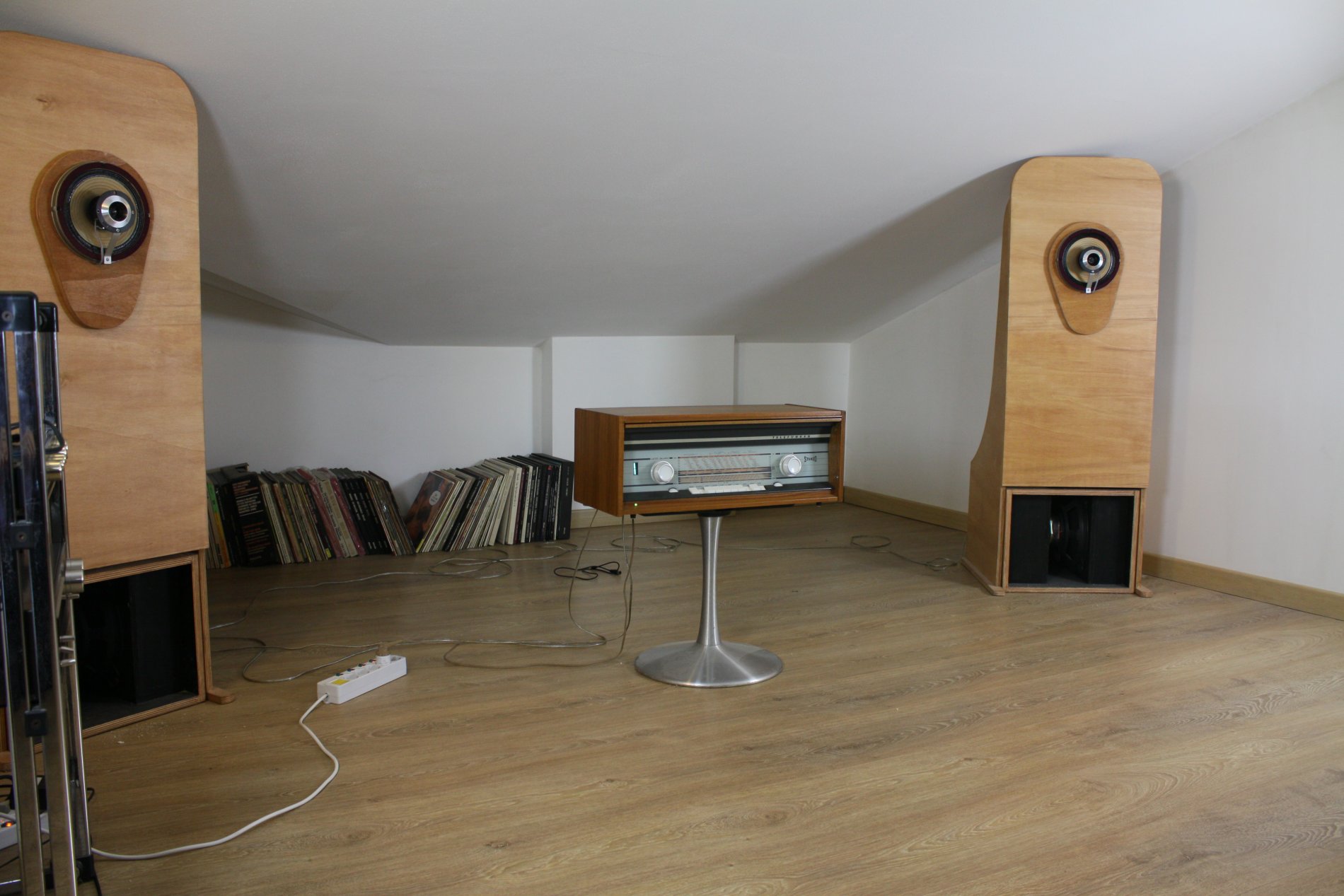
The coupling of this receiver with high efficiency speakers is perfect.
Any Open Baffle, or JBL, Altec, Cervin Vega and Jensen.
Satellite speakers with hidden subwoofer are also fine.
However, the receiver is unable to drive low efficiency speakers, such as the AR3A and similar models.
As with each Hi-Fi amplifier from this time period, the Concertino 2380 has separate bass and treble control. An interesting feature is that the high-tone control also changes its efficiency with the volume variance, because of its association with the loudness circuit.
There is also a system of correction for the frequency response, consisting of two buttons that insert preset equalization curves. The BASS button emphasizes the low frequencies while the Jazz button emphasizes the high frequencies.

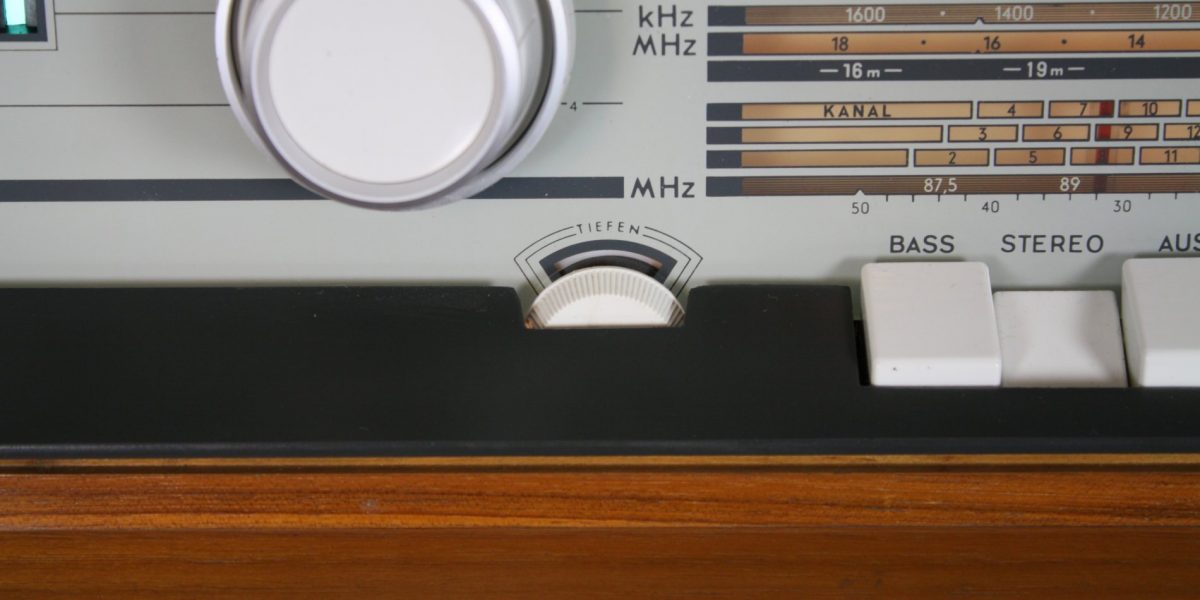


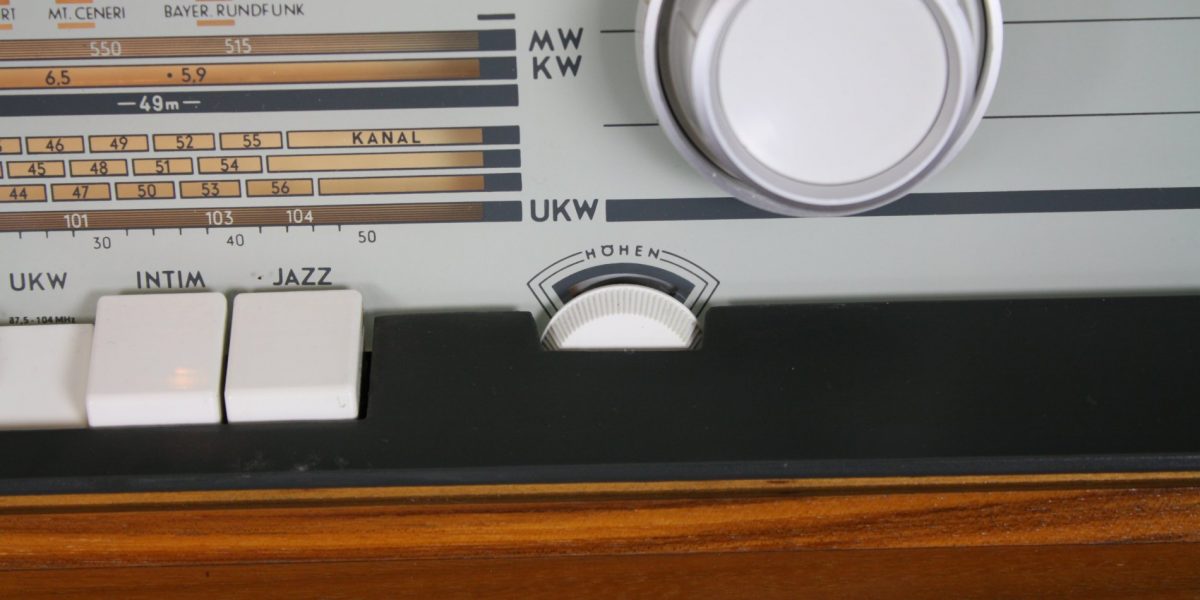



Inside the Cabinet there is a dipole to receive FM bands and Shortwaves. A ferrite rotating antenna is for long and medium waves reception. The ferrite antenna can be rotated from the outside to collect the maximum possible signal while receiving two AM bands.
In the picture you can see the entire mechanism of the antenna’s rotation. Using the internal antennas, the sensitivity is very good. Of course, under some conditions, using an external antenna further increases the receiver’s sensitivity.
The tuning system is interesting and different than other devices made in Germany. The device is equipped with separate tuning mechanisms for AM and FM bands. There are two tuning knobs, separate but coaxial, with cable and pulley systems separated depending on the band. This type of tuning has a very strong mechanics.
Regarding maintenance, cleaning and lubricating once every 10 to 15 years is sufficient.
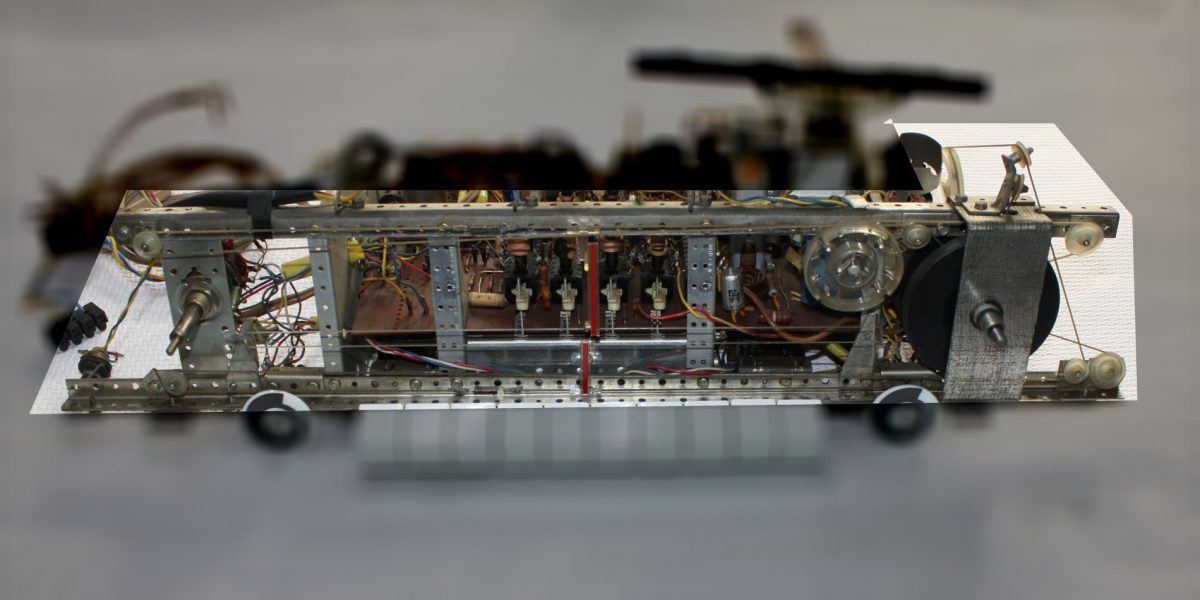





The magic eye has of course been replaced.
To the right is the Magic Eye, which indicates the perfect tuning position for each station.
You can also see the coaxial volume controls (with built-in loudness) and balance controls.
Just below there’s the Bass control knob.
At the top we can find the dial glass.
Below, in order,
- the BASS switch (bass boosted),
- STEREO, AUS (off),
- LW (long wave), MW (medium wave), KW (shortwave), UKW(FM),
- INTIM (reduces the volume by 20 dB),
- JAZZ (treble emphasis).
Finally there are AM/FM Tuning knobs.
Below, you can see the high-tone control knob.

Output for external speakers.
Socket for recorder (tonbandgerat).
Turntable input (Tonabnehmer)
AM and FM aerial inputs and ground socket.





